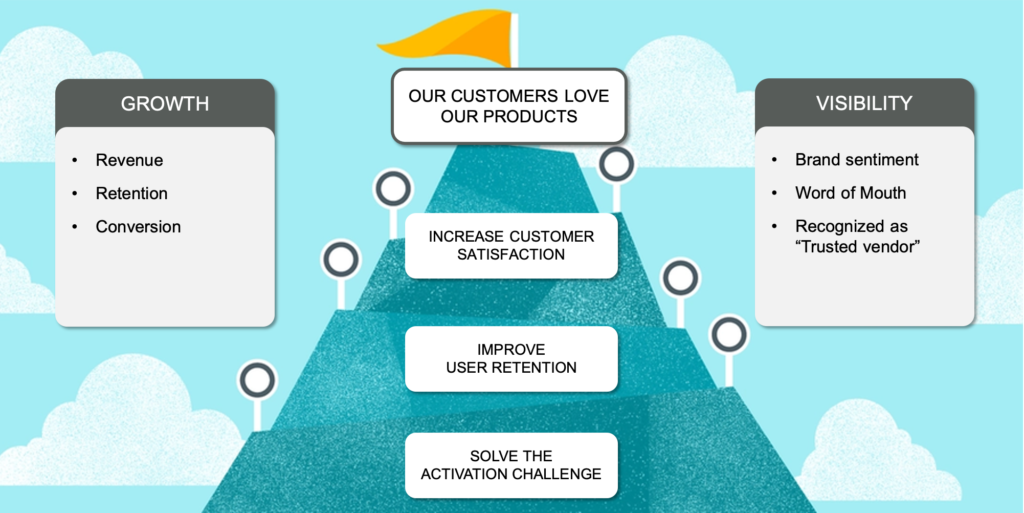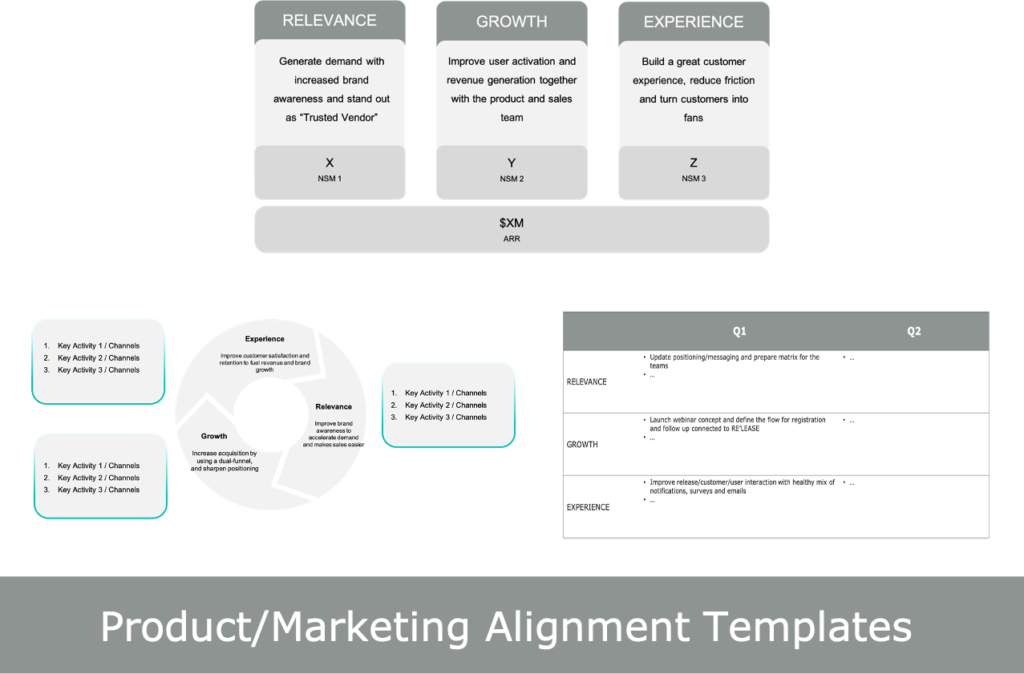In startups, we regularly talk about the importance of alignment between sales and marketing. But what about product and marketing? That is usually taken for granted. A few hyper-growth companies whose marketing/growth/product machine runs like clockwork serve as an example.
At first glance, marketing and product seem to have different goals. However, it is actually the path to these goals that is different. Marketing tells the story around the product and the company, fills the funnels and ensures that the products find their users. Product develops and delivers a great experience to solve a problem. The goals are derived from the company goals and in the end, marketing and product want the same thing: new users, paying users, happy users—and yes, revenue.
Yes, there’s much more but let’s keep it simple since our focus is on aligning the teams, and not going into the weeds. I wrote the article from my experience with marketing and product teams in startups in the growth phase. I have included thoughts and input from discussions with leaders from both areas. In particular, I would like to thank Alexandra Kleemann, CMO at Shpock, for her input and feedback.
What is the impact of a gap between product and marketing?
As Zainab Ghadiyali and Ravi Mehta put it in their article “The Product Strategy Stack“: We cannot have a company strategy without knowing our company’s mission. We cannot have product goals without knowing our product strategy.
I would like to add: We cannot reach our company goals without building the bridge between marketing and product. We cannot reach our marketing goals without building brand and growth around the product experience.
Here are the typical recurring problems:
- Marketing (especially brand/PR) and product teams are disconnected
- Early-stage startups often don’t have dedicated growth teams which connect product and marketing
- Lack of understanding of the respective goals
- Limited knowledge about user behavior and user adoption
- Goals are not clear for the teams or not connected
- Using different language and wording when talking about the same
- Perceiving company goals differently which leads to misaligned vectors
The result is that many activities go nowhere and resources are wasted. Customers and users are bombarded with notifications and emails by both teams instead of creating a positive impact on the user journey. The teams blame each other when retention is not as expected.
I see the pattern especially in younger B2B startups (pre-Series B), with a strong engineering focus in the product, as well as teams with complex tech products. In my current position at RE’FLEKT, an enterprise AR startup, we had a similar challenge and solved it with the plan described here. We created a common ground and have since extended the approach to the entire company.
3 Steps, a simple template, and a whiteboard is all you need
The 3-step plan I describe below is simple and can be started and implemented immediately and without much effort. The procedure can be adapted and deepened in many places, but my goal is to show a simple way that has been successful for us and helps to achieve our goals more easily and make our customers happier.
1. Find a Hook
“Our customers love our products” is the simple hook we use. And as you can see in the figure, this is at the top of the company goals. Of course, revenue is always the top priority, and in addition to growth and visibility, there are other corporate goals around team and culture. The picture shows a simplified representation with the focus on the hook. The core message is that if users love the products, revenue and visibility will come automatically.

In the first step:
- Define a hook as an “umbrella” topic, and
- Get the commitment from the CEO and the management.
Startups hook customers and users with the product experience, with the brand—by using simple headlines and claims. Anyone who wakes our team up at three in the morning and asks for the goal will hear: “Our customers love our products”. This hook serves as a motto for our most important event and our customers recognize us with it.
A unified hook reminds the teams of the common goal in all ideas, visions, and decisions. The question of whether to do x, y or z in marketing or product recedes into the background, the core of the discussion is around what is better so that “Our customers love our products”.
However, the hook needs buy-in from management, especially the CEO. The teams notice very quickly when a topic consists only of meaningless words without substance. Discuss possible hooks with the CEO and involve other executives as internal influencers who are committed and tell the story.
2. Define high impact Pillar Topic
Now that the hook has been defined and the CEO and other influencers have been briefed, it’s time to bring the teams along, build bridges and align the goals.
In the second step:
- Define a pillar topic supporting with the umbrella (User activation),
- Show the methodology and wording and,
- Set up a workshop and brief the moderators.
While the hook forms the common goal at the company level—the Umbrella Topic—there is a need for Pillar Topics with great importance. The higher the focus and attention on the part of C-level and management for the Pillar Topics, the stronger their effect on the team alignment.
Our most important Pillar Topic is User Activation. Our CEO has made it a priority to improve activation, which gives us the perfect foundation to work on with the teams. Marketing and Product, as well as Sales, Support and Delivery, are concerned with User Activation but have different approaches.
I think focusing the team initially on an area that has highly visibility/awareness among the exec team is a smart move even if the team doesn’t think it is the “best” place to focus based on other criteria. It can help build credibility and create the room to take on other lower visibility but important initiatives.
Brian Balfour, CEO and Founder of Reforge
After we had defined our Pillar Topic, we started tackling the language challenge. A common cause of misalignment is that teams use different wording but mean the same thing. User activation, user adoption, user growth—just one example of different wording.
The Workshop Kick-off to involve the teams
In our case, a workshop under the umbrella of “Our customers love our products” helped us to get the team member’s involvement and discover synergies. From my own experience I can give the following recommendations on the structure and content:
- Define moderators in the teams as representatives and interface.
- Prepare examples from well-known companies or tools your team members use (we used Figma, Miro, Uber) to explain why users love these products.
- Explain the user journey in detail and show the psychology behind why and how users use a product, a feature, and how they form/change a habit.
- Use clear wording and highlight specific terms which you want to use later for the plan (e.g. user activation, onboarding, net promoter score).
- Brief the moderators before the workshop and provide a channel where they can ask questions (in our case Slack).
To make the workshop effective, it makes sense to inform the team in advance about the process. This can be done by the moderators or by the CEO. We have prepared the most important topics on slides and recorded a video that explains the basics. This made it easier for the teams to jump right in. We started with an hour for the briefing and 90 minutes for the brainstorm session which was a crisp start.
3. Align the team goals
The key to sustainable success lies more in simplicity and consistency rather than developing complex strategies. The teams have their roadmaps and plans—the alignment issue must be easy to incorporate.
In the third step:
- Provide a framework to build a plan (find the templates below)
- Break up silos with C-level as a role model (different leaders for the teams)
I use simple templates that you can copy and customize. The templates simplify the start because the teams do not have to think about the structure. The example shows a simplified form of our plan based on marketing goals and activities.
Build a simple plan to bridge the gap
In the workshop, teams start collecting and discussing their most important goals and KPIs with a focus on Umbrella and Pillar Topic. What can product and marketing do in order to improve the user activation and make sure that our customers love our products?
It can be an improved UI, a new feature, educational content, or better analytics. All of the topics can be influenced by marketing and product–as well as by sales, customers success, service and support.

Goals, Strategy, Tactics in three templates simplify the initial discussion. The goal is to identify common ground, not to build a complex strategy. Once the initial starting points have been defined, it is possible to identify commonalities and dependencies across the team.
Two other factors help ensure alignment: Transparency and breaking down silos. Ideas need to be visible in order to work together in a coordinated way. This can be done with OKRs or a visual representation in the form of a mind map showing all teams. We have now involved all teams which means that 11 teams are visualizing their contribution to “Our customers love our products”. A virtual whiteboard works for us to keep the teams involved.
In order for the teams to feel the commitment from management, it is important that there are follow-ups after the initial workshop until the structure is automated. We have defined the roles in C-level management in such a way that we accompany different teams but not our own. This provides insight, understanding and a common language.
Download the Product/Marketing Alignment templates:

The Outcome
Whether you want to align goals or link product and marketing more closely, a common theme and the visible impact in management are the basis for all vectors to work in the same direction.
We see success in the way roadmap or marketing strategy is planned and teams are asked for feedback or involvement on interdisciplinary topics instead of meeting isolated goals that do not contribute to success.
And if there is discussion about a feature or where the leads are coming from–always get back to why “Our customers love our products” 😀
Subscribe to my newsletter and follow me on LinkedIn and Twitter.
Dirk Schart is CMO of the Augmented Reality startup RE’FLEKT. His focus is on B2B enterprise software and SaaS models —from zero to hero. Dirk is a former Director SaaS Products & Digital at HyperloopTT, mentors startups at the German Accelerator in the Silicon Valley, and is the author of an Augmented Reality book for Marketing.
